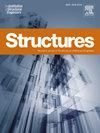评估腐蚀对中等延性钢弯矩框架抗震性能的影响
IF 4.3
2区 工程技术
Q1 ENGINEERING, CIVIL
引用次数: 0
摘要
大气腐蚀是金属在恶劣环境条件下发生腐蚀的电化学过程。在钢结构中,腐蚀会产生巨大的财务成本,并对结构安全产生负面影响。为了评估腐蚀对结构抗震性能的影响,首先对结构进行了动态分析,然后根据性能标准对结构的损伤程度进行了评估。本文采用增量动力分析(IDA)方法对中等延性钢质抗弯矩框架进行了研究。对3层、5层和8层的三种框架模型进行了分析,考虑了0、20和50年的腐蚀影响。在OpenSEES软件中对结构进行建模,并根据ISO 9223和ISO 9224标准确定腐蚀厚度。使用HAZUS-MH MR5标准中定义的最大层间漂移比来评估钢框架的性能水平。根据易损性曲线结果,与未腐蚀情况相比,三层、五层和八层结构在腐蚀20年后完全倒塌的中位数概率分别增加了4.93 %、1.14 %和2.44 %。50年后,与无腐蚀条件相比,这些概率分别增加到8.21 %,4.55 %和7.32 %。此外,在第0年、第20年和第50年,5层框架相对于3层框架的倒塌概率变化百分比分别为21.34 %、18.21 %和18.21 %,而8层框架的相应变化百分比分别为26.57 %、24.65 %和25.85 %。本文章由计算机程序翻译,如有差异,请以英文原文为准。
Assessing the impact of corrosion on the seismic performance of moderately ductile steel moment frames
Atmospheric corrosion is an electrochemical process that deteriorates metals under harsh environmental conditions. In steel structures, corrosion incurs significant financial costs and negatively impacts structural safety. To assess the effect of corrosion on seismic performance, the structure is first analyzed dynamically, and the damage level is then evaluated based on performance criteria. In this study, the Incremental Dynamic Analysis (IDA) method was employed to investigate steel moment-resisting frames with moderate ductility. Three frame models with 3, 5, and 8 stories were analyzed, considering corrosion effects at 0, 20, and 50 years. The structures were modeled in OpenSEES software, and corrosion thickness was determined based on ISO 9223 and ISO 9224 standards. The performance levels of the steel frames were evaluated using the maximum inter-story drift ratio as defined in the HAZUS-MH MR5 standard. Based on the fragility curve results, the median probability of complete collapse for the three, five, and eight story structures increased by 4.93 %, 1.14 %, and 2.44 %, respectively, after 20 years of corrosion compared to the uncorroded cases. After 50 years, these probabilities increase to 8.21 %, 4.55 %, and 7.32 %, respectively, compared to the corrosion-free condition. Additionally, the percentage change in collapse probability for the 5-story frame compared to the 3-story frame is 21.34 %, 18.21 %, and 18.21 % in the 0th, 20th, and 50th years, respectively, while for the 8-story frame, the corresponding changes are 26.57 %, 24.65 %, and 25.85 %.
求助全文
通过发布文献求助,成功后即可免费获取论文全文。
去求助
来源期刊

Structures
Engineering-Architecture
CiteScore
5.70
自引率
17.10%
发文量
1187
期刊介绍:
Structures aims to publish internationally-leading research across the full breadth of structural engineering. Papers for Structures are particularly welcome in which high-quality research will benefit from wide readership of academics and practitioners such that not only high citation rates but also tangible industrial-related pathways to impact are achieved.
 求助内容:
求助内容: 应助结果提醒方式:
应助结果提醒方式:


